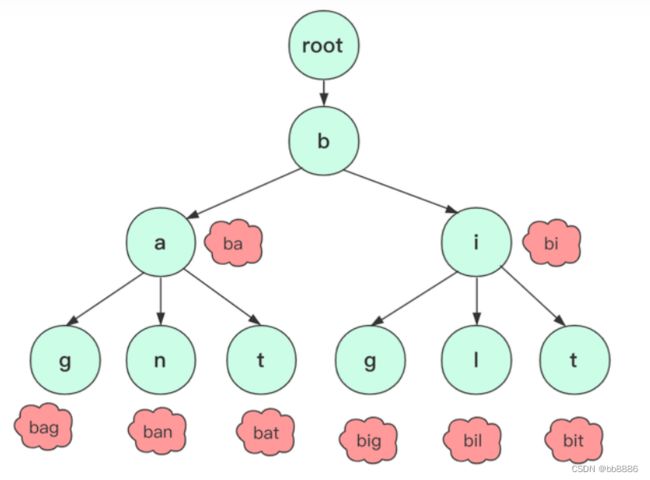数据结构(7.5)-- 树扩展之字典树
一、字典树
1、字典树介绍
字典树,也称为“前缀树”,是一种特殊的树状数据结构,对于解决字符串相关问题非常有效。典型
用于统计、排序、和保存大量字符串。所以经常被搜索引擎系统用于文本词频统计。它的优点是:
利用字符串的公共前缀来减少查询时间,最大限度地减少无谓的字符串比较,查询效率比哈希树
高。
2、字典树的性质
(1)根节点不包含字符,除了根节点每个节点都只包含一个字符。root节点不含字符这样做的目的是为了能够包括所有字符串。
(2)从根节点到某一个节点,路过字符串起来就是该节点对应的字符串。
(3)每个节点的子节点字符不同,也就是找到对应单词、字符是唯一的。
3、字典树的实现
(1)定义多叉树--孩子表示法
struct TreeNode {
ELEMENT_TYPE value; //结点值
TreeNode* children[NUM]; //孩子结点
};(2) 定义字典树
int size = 26;
struct TrieNode {
bool isEndOfWord; //记录该结点是否是一个串的结束
TrieNode* children[SIZE]; //字母映射表
};二、面试中关于字典树的常见问题
1、计算字典树中的总单词数
题目:创建一颗字典树,并且计算该字典树中的总单词数。如下字典树,[“bag”, “ban”, “bat”, “big”,“bil”,“bit”],单词数为6。
思路:
首先要创建一颗字典树,在每个节点上,设置一个标记来表示该节点是否是一个单词的结束。
再向字典树中插入单词,从根节点开始,递归地遍历字典树的所有子节点。
最后计算单词数:对于每个子节点,如果其标记为结束,则将计数器加1。最终,计数器的值就是字典树中的总单词数。
#include
using namespace std;
const int ALPHABET_SIZE = 26;
// TrieNode表示字典树中的节点
struct TrieNode
{
bool isEndOfWord; //用于标记该节点是否是一个单词的结束
TrieNode* children[ALPHABET_SIZE]; //包含26个子节点的数组
// 构造函数
TrieNode():isEndOfWord(false){
for(int i = 0; i < ALPHABET_SIZE; i++){
children[i] = nullptr;
}
}
};
class Trie{
private:
TrieNode* root;
public:
Trie(){
root = new TrieNode();
}
// 向字典树中插入单词
void insert(string word){
TrieNode* current = root;
// 遍历字符串中的字符
for(char ch: word){
int index = ch - 'a';
if(current->children[index] == nullptr)
current->children[index] = new TrieNode();
current = current->children[index];
}
// 遍历结束,标记该节点单词结束
current->isEndOfWord = true;
}
// 计算字典树中的总单词数
int countWords(){
int count = 0;
countWordsDFS(root, count);
return count;
}
private:
// 深度优先搜索(DFS)递归地遍历字典树的所有节点,并在遇到结束节点时将计数器加1。
void countWordsDFS(TrieNode* node, int& count){
if(node == NULL)
return;
if(node->isEndOfWord)
count += 1;
for(int i = 0; i < ALPHABET_SIZE; i++){
if(node->children[i] != NULL)
countWordsDFS(node->children[i], count);
}
}
};
int main(){
Trie trie;
trie.insert("bag");
trie.insert("ban");
trie.insert("bat");
trie.insert("big");
trie.insert("bil");
trie.insert("bit");
int count = trie.countWords();
cout << "字典树中的总单词数:" << count << endl;
}
2、查找字典树中某个单词是否存在
题目:输入ban,返回true;输入bad,返回False。
思路:和插入操作类似。
从字典树的根节点依次遍历单词中的字符,如果当前节点的子节点中,不存在键为 ch 的节点,则说明不存在该单词,直接返回 False。如果当前节点的子节点中,存在键为 ch 的节点,则令当前节点指向新建立的节点,然后继续查找下一个字符。在单词处理完成时,判断当前节点是否有单词结束标记,如果有,则说明字典树中存在该单词,返回 True。否则,则说明字典树中不存在该单词,返回 False。
#include
using namespace std;
const int ALPHABET_SIZE = 26;
// TrieNode表示字典树中的节点
struct TrieNode
{
bool isEndOfWord; //用于标记该节点是否是一个单词的结束
TrieNode* children[ALPHABET_SIZE]; //包含26个子节点的数组
// 构造函数
TrieNode():isEndOfWord(false){
for(int i = 0; i < ALPHABET_SIZE; i++){
children[i] = nullptr;
}
}
};
class Trie{
private:
TrieNode* root;
public:
Trie(){
root = new TrieNode();
}
// 向字典树中插入单词
void insert(string word){
TrieNode* current = root;
// 遍历字符串中的字符
for(char ch: word){
int index = ch - 'a';
if(current->children[index] == nullptr)
current->children[index] = new TrieNode();
current = current->children[index];
}
// 遍历结束,标记该节点单词结束
current->isEndOfWord = true;
}
// 查找字典树中某个单词是否存在
bool searchWord(string word){
TrieNode* current = root;
for(char ch: word){
int index = ch - 'a';
if(current->children[index] == NULL)
return false; //如果当前节点的子节点中,不存在键为 ch 的节点,直接返回false
current = current->children[index];
}
// 判断当前节点是否为空,并且是否有单词结束标记
return (current->isEndOfWord & current != NULL);
}
};
int main(){
Trie trie;
trie.insert("bag");
trie.insert("ban");
trie.insert("bat");
trie.insert("big");
trie.insert("bil");
trie.insert("bit");
string word = "bad";
bool b = trie.searchWord(word);
if(b)
cout << "该字典树存在" << word;
else
cout << "该字典树不存在" << word;
}
3、查找字典树中某个前缀是否存在
在字典树中查找某个前缀是否存在,和字典树的查找单词操作一样,不同点在于最后不需要判断是否有单词结束标记。
// 查找字典树中某个前缀是否存在
bool searchWord(string word){
TrieNode* current = root;
for(char ch: word){
int index = ch - 'a';
if(current->children[index] == NULL)
return false; //如果当前节点的子节点中,不存在键为 ch 的节点,直接返回false
current = current->children[index];
}
// 判断当前节点是否为空
return current;
}4、打印存储在字典树中的所有单词
题目:如下字典树,打印[ bag,ban,bat,big,bil,bit ]。
思路:在哈希遍历树的完整路径中,我们使用先序遍历逐步构建叶子节点的路径。本题类似,使用
深度遍历递归地遍历字典树的所有子节点,并存储每个叶子节点的字符串。遇到叶子节点(即
isEndOfWord=true),则打印存储在容器里的字符串(字符串组合起来就是一个完整单词)。
#include
using namespace std;
const int ALPHABET_SIZE = 26;
// TrieNode表示字典树中的节点
struct TrieNode
{
bool isEndOfWord; //用于标记该节点是否是一个单词的结束
TrieNode* children[ALPHABET_SIZE]; //包含26个子节点的数组
// 构造函数
TrieNode():isEndOfWord(false){
for(int i = 0; i < ALPHABET_SIZE; i++){
children[i] = nullptr;
}
}
};
class Trie{
private:
TrieNode* root;
public:
Trie(){
root = new TrieNode();
}
// 向字典树中插入单词
void insert(string word){
TrieNode* current = root;
// 遍历字符串中的字符
for(char ch: word){
int index = ch - 'a';
if(current->children[index] == nullptr)
current->children[index] = new TrieNode();
current = current->children[index];
}
// 遍历结束,标记该节点单词结束
current->isEndOfWord = true;
}
void printWord(){
string arr;
print(root, arr);
}
private:
void print(TrieNode* node, string& arr){
if(node->isEndOfWord){
for(auto a: arr)
cout << a;
cout << "," ;
}
for(int i = 0; i < ALPHABET_SIZE; i++){
if(node->children[i] != NULL){
char ch = i + 'a';
arr.push_back(ch);
print(node->children[i], arr);
}
}
arr.pop_back();
}
};
int main(){
Trie trie;
trie.insert("bag");
trie.insert("ban");
trie.insert("bat");
trie.insert("big");
trie.insert("bil");
trie.insert("bit");
trie.printWord();
}
5、使用字典树对数组的元素进行排序
题目:
input:arr = ['apple', 'banana', 'application']
output:arr = ['apple', 'application', 'banana']
思路:同第二题,因为字典树节点的顺序已经确定,所以,遍历出来的单词即是排序后的单词组。
#include
#include
using namespace std;
const int ALPHABET_SIZE = 26;
// TrieNode表示字典树中的节点
struct TrieNode
{
bool isEndOfWord; //用于标记该节点是否是一个单词的结束
TrieNode* children[ALPHABET_SIZE]; //包含26个子节点的数组
// 构造函数
TrieNode():isEndOfWord(false){
for(int i = 0; i < ALPHABET_SIZE; i++){
children[i] = nullptr;
}
}
};
class Trie{
private:
TrieNode* root;
public:
Trie(){
root = new TrieNode();
}
// 向字典树中插入单词
void insert(string word){
TrieNode* current = root;
// 遍历字符串中的字符
for(char ch: word){
int index = ch - 'a';
if(current->children[index] == nullptr)
current->children[index] = new TrieNode();
current = current->children[index];
}
// 遍历结束,标记该节点单词结束
current->isEndOfWord = true;
}
vector Order(){
string arr;
vector s;
traverse(root, arr, s);
return s;
}
private:
// arr:连接字符串组成的单词,res:排序后的数组
void traverse(TrieNode* node, string& arr, vector& res){
if(node->isEndOfWord){
res.push_back(arr);
}
for(int i = 0; i < ALPHABET_SIZE; i++){
if(node->children[i] != NULL){
char ch = i + 'a';
arr.push_back(ch);
traverse(node->children[i], arr, res);
}
}
arr.pop_back();
}
};
int main(){
Trie trie;
vector arr = { "apple", "banana", "application" };
for (const string& word : arr)
trie.insert(word);
vector sortedArr = trie.Order();
std::cout << "排序后的数组元素:" << std::endl;
for (const std::string& word : sortedArr)
std::cout << word << std::endl;
}




